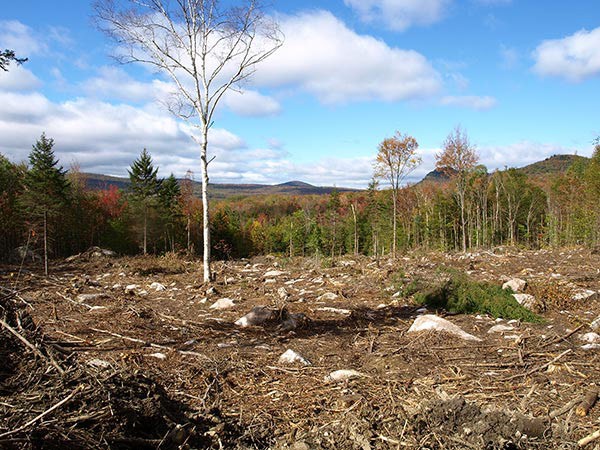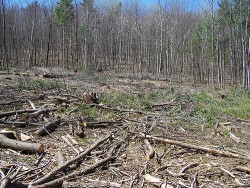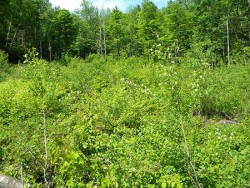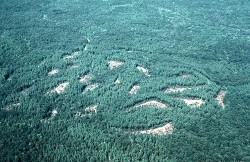
“They had to leave the hollies,” Brian Tefft said, pointing across an opening studded with snow-touched slash to a pair of green-bowered bluebirds. “That was one stipulation. There’s no commercial value and they’re a local favorite. Birds love them.”
Apart from these broad-leafed evergreens, a couple dozen oaks dotted the ten acres. Clenched tight to one scarlet specimen, a red-shouldered hawk perused the newborn field.
“There’s a happy bird,” said Tefft, who is Principal Wildlife Biologist for Rhode Island’s Department of Environmental Management. “Grass has already sprouted, and with the slash – they had to spread it out to keep deer off the shoots – we have fine cover for mice. Rabbits, too. You’d be amazed how fast regeneration is, particularly with the retained masts. Look over here.”
He walked thirty yards south, boots shedding snow, then stopped. A wall of saplings, well overhead, bifurcated two habitats, a deer mouse’s pick-pock tracks undulating the border.
“Look how thick this is. This cut was 2007, the field 2012. Five years gives you young forest, and this is lousy soil, all pasture back in the day, not crops.” He bent one of the taller saplings, sniffing. “Like spearmint – a sassafras. They grow fastest, but mostly we’ll end up with oak and maple, some black gum and beech. Not much poplar like farther north, but you see the paper birch. Woodcock will use the open area for singing grounds, and this growth here for breeding. They feed down in the riparian zones. It’s an ideal mix now.”
We were talking about the Great Swamp Management Area in south-central Rhode Island. Two clearcuts were completed here in 1995, three in 2007, then two in 2012. There are two more rounds on the way. The idea is that the young forest conditions will help restore the region’s grouse population, which has been severely depleted over the past few decades.
“The Arcadia Management Area had a check station for four weekends a season through the 1990s,” Tefft said, “and they’d register seventy, eighty birds. Now you’re hard pressed to hear a single drum in spring.” In 2012, Rhode Island closed ruffed grouse hunting, unthinkable even ten years ago.
As Northeastern farmland has cycled to shrubland, then pole timber, and now to older woodlands, clear cutting and patch cutting are the most common ways to maintain a percentage of forest in early succession. The Great Swamp is Rhode Island’s principal experiment. Partnering with the U.S. Fish and Wildlife Service and the Natural Resources Council, the Department of Environmental Management takes private landowners on tours here, hoping to nudge them toward what they see as sound stewardship. The aim is to maintain roughly sixty percent of Rhode Island’s forest in maturity, while promoting diverse habitat in the rest and, by extension, diverse fauna.
Context is Key
Largely spurred by the century-old suppression of floods, fires, and beaver activity, the belief that re-invigorating early successional habitat is critical to wildlife management is held by a vast managerial majority throughout the Northeast, supported largely by U.S. Forest Service studies under Bill Leak, Mariko Yamasaki, and their colleagues at the Northeastern Forest Experiment Station.
Their book, New England Wildlife: Management of Forested Habitats, establishes that stands in the seedling and sapling stage attract the most wildlife species; once a stand gets beyond pole timber, it becomes less useful to many birds and mammals, even certain reptiles and amphibians. A diversity of forest age classes, then, should be the goal when managing for wildlife, as old is not necessarily good from an animal’s perspective. A stand of even-aged sawtimber, for example, has about the same diversity of animal life as an old forest.
Context is key. “In a 40-acre parcel in agricultural, southern New England, we would not suggest even-aged management with five- to ten-acre clearcuts,” they write. “In contrast, in a 500-acre parcel in the extensive forest of northern New England, use of clearcut regeneration would be very appropriate to provide a range of habitat conditions.”
“In New Hampshire, which is 81 percent forested, sawsized timber acreage is increasing, while early successional shrinks,” said Yamasaki. “Well-executed clearcuts generate a set of ephemeral conditions where various soft mast species (wild strawberries, juneberries, raspberries, blackberries) can flourish for a few years before trees reclaim the land. The stem densities that make walking through such areas difficult are what make favorable nesting and foraging places for early successional songbirds and important post-fledging habitat for many other forest songbirds. Clear-cutting is just one tool, but an important one in promoting a habitat spectrum attractive to all species.”
Rocky Bunnell, a logger and lifelong hunter from Monroe, New Hampshire, speaks to the value of clearcuts to game species. “When we do a cut or I know of a guy who’s done some patches, that’s where I’ll hunt – turkeys right away, especially when there’s good mast retention. Deer and moose love the new growth a couple years later, and grouse and snowshoes come in five, maybe ten years later when it thickens up, but once that starts you get thirty years of decent hunting.”
Mainstream ecologists agree that forest disturbance – whether natural (beavers, fires, storms) or man-made (logging) – is an important part of ecosystem health. And yet acceptance of clearcutting to create early successional habitat is not generally favored by the public, many of whom can be outright hostile to it.
Part of this is visceral. Turning a forest is not like turning a field. To those unaccustomed to the sights and sounds of falling trees, even a two-acre clearing can evoke a Loraxian apocalypse.
Part is cynicism. One prevailing environmentalist notion, for instance, maintains that only timber industry propaganda claims that clearcuts benefit wildlife, all in an effort to disarm a properly upset public. Most foresters see this as ill-informed, yet many say that very sentiment profoundly influences forest policy debates and, quite often, a forester’s decisions.
“I work with a lot of foresters,” says Bunnell, “and can’t tell you how many times I’ll ask, ‘Why isn’t this block being managed? It’s not doing well.’ You know, a lot of sick trees, or maybe guys highgraded it years ago and left stuff that won’t reach full potential, either for logging or wildlife. They’ll say, ‘I know, but you can see it from Route 3.’ They just don’t want the public headaches.”
Another contention stems from the different ways people look at ecological time. The more sober voices caution against using the last a hundred years as a reference for determining how to manage woods. In other words, we can’t make judgments based on the percentage of land in early successional stages in the 1960s.
“People need an appropriate reference,” said Mollie Matteson, Conservation Advocate with the Center for Biological Diversity’s Richmond, Vermont, branch. “While certain species benefit from early successional habitat, the truth is that the peak we grew up with was an artificial boom, with clearing through the 19th century as the massive disturbance that allowed it. To me, this precludes the last hundred years as a framework. Pre-Contact New England was 95 percent forest cover and, contrary to many opinions, multi-aged. Beavers created early successional habitat everywhere, and along with lesser windthrows and fire you had big events. Sandy and Irene obviously weren’t the first. Great blocks of interior forest are crucial, and I only suggest we use the proper timeframe.”
Harry White, director of the Weantinoge Land Heritage Trust in northwestern Connecticut, puts it this way:
“There’s a misconception that New England’s forests are overripe, but maturity for many forest types here runs three to eight hundred years. Cutting, even clear-cuts, has a place, but there’s an argument for old growth. Look at the Phelps Research Area in Colebrook [Connecticut]. It was cut in 1912, but even with a hundred years the place is spectacular, and people should stop omitting no logging as an option, especially on public land.”
Clearcut debates, then, on philosophical, theoretical, and practical levels, currently preoccupy much of northeastern forest management, all begging the question: How do you know when a clearcut is a good idea? What does a responsible one look like? What’s a reasonable justification? And while the answers are varied and site specific, there are some general rules worth noting that can be particularly valuable to property owners as well as anyone concerned with proposed clearings on a cherished public plot.
Wildlife Habitat
A healthy forest is a diverse forest – a mix of young woods, old woods, wetlands, and water. In heavily forested areas, clearcuts provide the young forest element of this mix, particularly in lieu of the aforementioned floods and fires, along with modern beaver populations that pale with historic abundances. Even the effects of big storm events are largely mitigated now with most timber stands roughly in an adolescent phase, with the majority of trees strong enough to withstand high winds.
Phil Brown, Conservation Director for Audubon New Hampshire, has supervised two wildlife motivated clearcuts at Willard Pond in Hancock and Bellamy Pond in Dover. At Bellamy, the goal was to promote the cottontail population. Timber wasn’t harvested, and select black gum and oak trees were felled and left on the ground in a way that resembled windthrow. At Willard, a harder sell, sixteen acres of chip-grade white pine were removed from reclaimed pasture. “I had internal struggles,” Brown said, “but it released the apples and we’ve seen birds thought to be deep forest only use regenerated edges, like ovenbirds, particularly in the fledgling stage. More insects and better cover.”
Placing a potential habitat improvement cut within a broader context is essential, particularly in the heavy fragmentation of southern New England, or even southeastern New Hampshire and greater Burlington. Many voices here echo those of Leak and Yamasaki. Geoff Krukar, an avian researcher with the Connecticut Department of Energy and Environmental Protection and a strong advocate for appropriate clearing, cautions against clearcutting smaller forest plots abutting development. “Whatever benefits you might gain with young forest growth are generally nullified when you open up woodlands in predator-heavy suburban zones, which will give raccoons, housecats, and cowbirds – among others – easy access to nesting sites.”
Forest Health
Clearcuts can remedy the sins of our fathers, who, through practices such as high-grading and plantation growth, have left certain sections of today’s forests in poor health. Several cuts in Massachusetts’ Quabbin Watershed, for instance, which generated voluminous public objection, were prescribed to remove diseased red pine plantations and allow a more naturally functioning forest to re-establish. In other instances, a clearing can begin anew when pests or pathogens have afflicted a stand or where the best, most vigorous trees have been removed, leaving only runty, crooked stock. Tim Mooney, with the Rhode Island Nature Conservancy, worked with Brian Tefft and others to implement such cuts on Tillinghast Pond in West Greenwich.
“At Tillinghast, we cleared a 27-acre parcel and an 11-acre one (out of 2,200 total acres). These were poor quality stands – twenty-year-old, unhealthy white pine in one, and mostly oak with a white pine understory in the other. The oaks, though, had 50 percent mortality. I carried into my professional life a desire never to see a tree cut, but having seen bird diversity jump by a third following the harvest – especially some troubled species like field sparrows, prairie warblers, and woodcock – that emotional wrestling is gone. You walk those transitional zones in spring now and hear a great deal more chatter than you used to. Now all I think is, ‘Where can we do more?’”
Landowner Fred Ernst has managed his 620-acre Acworth, New Hampshire, property to rectify past logging abuses.
“We’ve done five cuts over four years, from five to seventeen acres, and though we’ll slow down, we’re getting everything we hoped for. This is old farmland that has been high-graded over the years, leaving some poor stands. Where we’ve cut we’re getting aspen, oak, and maple regeneration, while leaving plenty of interior forest.”
Preferred Species
Silviculture of any kind has the aim of fostering certain tree species, which can serendipitously wed commercial and ecological benefits. Such forest plans vary by region. In northern New England, where undesirable species like beech or hay-scented fern are present, patch cuts and small clearcuts can help out the more desirable species. “Beech thrives under partial harvesting,” said Rob Bryan, a Maine forester, “so if you want higher grades like rock maple or yellow birch, then clearing is a good option.”
In southern New England, oak has become a preferred species, along with efforts to restore pitch pine, particularly in Connecticut. Deer browsing, fire suppression, and competitive invasives are a problem everywhere, but are especially bad in southern New England and oaks have suffered accordingly.
“Today’s oak stands had perfect conditions to come of age a hundred or more years ago,” said Emery Gluck, a forester with Connecticut’s Department of Energy and Environmental Protection. “Fires and charcoal clearings, the chestnut blight, and little to no deer browse. In 1896, twelve deer were reported in Connecticut. Things are obviously different now. Deer prefer oak to maple, birch, and beech, and we have a lot of sun-loving invasives here, like bittersweet and honeysuckle. Most oak seedlings, then, don’t make it, and we’re losing oak/hickory mixes to the ecologically less desirable maple/birch/beech stands.” Buttressing this last point, oak stand bird diversity is double that of maple forests, possibly, Gluck speculated, because of higher insect abundance in the deeply corrugated bark.
To thwart this trend of fading oaks, foresters are using a variety of techniques, with clearing only occasionally chosen.
“We shun a cookbook mindset,” Gluck said, “as doing the same thing all the time isn’t wise for biodiversity. Connecticut is certainly implementing clearcuts for wildlife purposes, especially New England cottontails, but when it comes to sustaining oak forests that won’t sustain themselves, variety is best.”
Like Phil Brown, Gluck and others often try to mimic natural events, such as microbursts, tornadoes, and windthrow. Shelterwood cuts (essentially a clearcut in slow motion, where two thirds of all the trees are cut, the understory is allowed to regenerate, then the rest of the overstory is harvested) are a favorite as well, but even then there are options. Gluck prefers to space retained trees, whereas a colleague often clusters them in tenth of an acre and larger patches. In each case, once the oak seedlings have a root collar the width of a pencil, usually in four to six years, a second cut is done.
Controlled fire is an increasingly popular choice as well, especially when both oak and pitch pine are the targeted regeneration species.
“This is forgotten,” Gluck said, “but many of Connecticut’s pines were pitch pine, nearly all of which were removed by the 1700s for making pine tar. Both oak and pine do well in burn conditions, and in fact evolved that way, so that’s a good choice, but it’s more than just lighting a match. At the Hopeville Pond [State Park] burn last spring, we had to take out all the white pine first, as we initially couldn’t get a hot enough fire. Now, though, preliminary results look good.”
Best Management Practices
As in all silviculture, best management practices must be applied. Many are universal, such as planning a harvest to limit soil erosion, spreading slash to protect shoots and provide initial wildlife ground cover, smoothing ruts and landings, and choosing the right skid/haul routes. In addition, while invasive control is paramount in any logging operation, it’s particularly critical in clearcutting, as many exotics adore both open sun and disturbed ground. In fact, if invasives dominate a stand, doing nothing can be the best option, while in other cases mechanical or herbicidal removal should precede the harvest.
For several reasons, public relations among them, followup is essential. If merchantable wood is a cut’s chief aim, a proper forest plan will include future harvest date recommendations. A common template is thinning at 50–60 years to release the best trees, while implementing another clearing or shelterwood cut in 100 years. Future site visits are vital to invasive control, as well, where any growth should be removed. This is true even of some native species like fox grape, an aggressive plant that strangles even large trees. Harry White, the Weantinoge director, deems anything else “slob logging.” “I mean, what will you have in ten years, the enchanted barberry forest?”
Mariko Yamasaki catalogs additional mandates to ensure a clearcut will do what all silviculture should: provide for the present while improving the future.
“In larger cuts,” she said, “smaller retention areas, often grouped around special features such as seeps, large cavity trees, conifer inclusions, hard mast trees, and others, increase diversity, and buffers or retention zones should be variably placed around slopes, different stream orders, and other features, sometimes in combinations of no-harvest zones and limited harvest areas. It should be noted, though, that on low-gradient streams patch and clearcuts up to the water can encourage beaver habitat through hardwood growth.”
The fact that Northeasterners are arguing over what to do with trees at all is a high-class problem, unthinkable to Depression era minds, though it shouldn’t surprise. If agreement on forestry practices can be sparse, it’s universally acknowledged that the Northwoods can take a punch. After all, the northern colonies were little more than a paddock, with Vermont alone keeping nearly two million sheep on denuded slopes well into the 19th century. Now the woods are back, though fragmented and compositionally different. While this seems a pleasant shock, history fuels fears that what’s here now can be gone tomorrow, with the slippery definitions of “what” and “now” coloring the clear-cut debate, variables for time and space. To some, such as Mollie Matteson, using our collective living memory as a reference point will jeopardize future forest health, while on the other pole some have seized on the decline of animals that depend on young forest – such as the American woodcock, brown thrasher, and New England cottontail – as an excuse to strategically whack away.
Jeremy Turner, a New Hampshire forester who assisted Phil Brown’s Audubon cuts and grew up amongst loggers in central New Hampshire, has an equatorial view:
“You want to be careful, as I’ve seen some really abusive cuts, but clearcuts can be critical in providing both diverse habitats and economically viable timber. We’re lucky. Our temperate forests regenerate beautifully. On the other hand, I hold to Aldo Leopold’s land ethic and the idea that some land should be left unmanaged by humans. There’s so much we don’t know, and we don’t want to break critical linkages or forego genetic stability by managing everything.”
The northeastern forests, then, have returned, towing with them a fractious array of opinions over proper management. For the time being, the practice of clearcutting will be hashed out in the heaven-hell swamps of democracy, which, despite our aggregate gripe otherwise, usually breed sensible, middle-path organisms. Cuts will be made, reserves will be set, no one will be entirely pleased, and the forest will go on influencing us as much as we do it.







